For the Long Run: Bright Road Ahead for PC Athletics
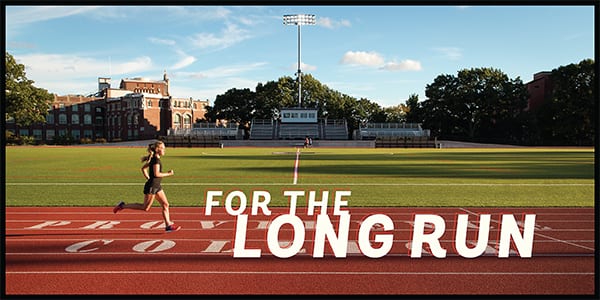
The road ahead has never looked brighter for Providence College athletics. The last two years have brought national championships in men’s ice hockey and women’s cross country, and conference titles in men’s basketball and men’s soccer. The campus gleams with new facilities. There’s never been a better time to say, Go Friars!
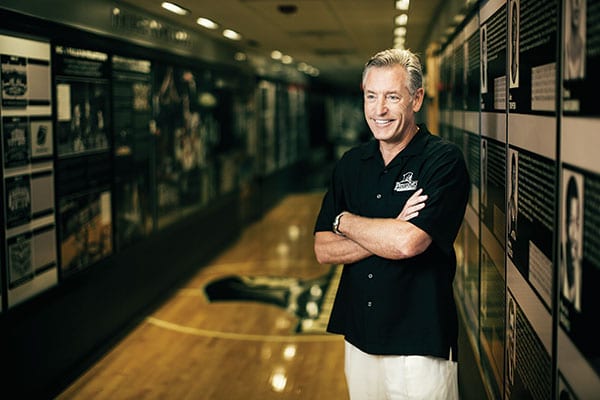
By Vicki-Ann Downing
Four years ago, Providence College needed a men’s ice hockey coach.
Robert G. Driscoll, Jr., associate vice president and athletic director, knew the person he wanted for the job.
Driscoll drove 180 miles to Schenectady, N.Y., to meet Nate Leaman in a coffee shop. Leaman’s Union College team, which awarded no athletic scholarships, was ranked fourth in the nation and had just made its first NCAA Division I Tournament appearance. Leaman was National Coach of the Year.
But Leaman did not say yes to Driscoll right away.
“It took a couple of weeks,” said Driscoll. “At the time, we had an outdated facility. We were in the toughest conference in the country. We were last in that conference. We hadn’t won in a long time.”
In 2015, in his fourth season at PC, Leaman coached the men’s team to its first NCAA Championship. Thanks to the generosity of donors, the team now plays its games in a renovated and modern Schneider Arena. Driscoll refers to Leaman, and coaches like him, as “architects of success.”
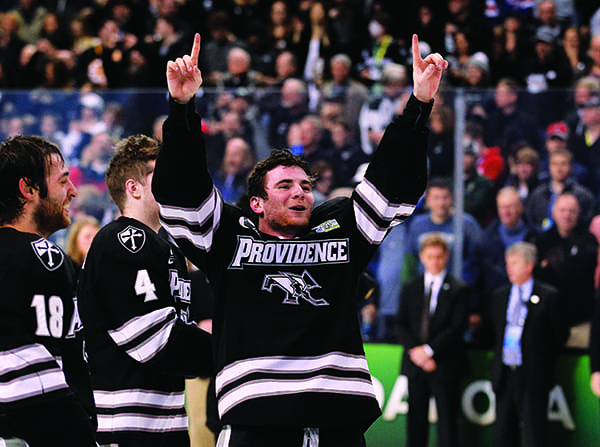
Driscoll is an architect himself. He arrived at PC in 2001 after 14 years in athletic administration at the University of California, Berkeley, with a vision to make PC a model program in college athletics — one that graduated every student-athlete, competed for national championships, and displayed the Catholic and Dominican values of honesty, integrity, and service.
He began with a “conversation of possibility.” What would success look like if there were no limitations? “We started with the concept of going from good to great. Being the smallest, best program,” Driscoll said.
“Having a vision and achieving a vision are two different things,” Driscoll acknowledged. “My understanding of Providence and what works here has changed. It’s longevity. You learn from it. And you have to have some luck, too.”
Driscoll credits his success to administrators who recognize that a great athletics program raises a college’s national profile — College President Rev. Brian J. Shanley, O.P. ’80 and the Board of Trustees under the leadership of Chairman John F. Killian ’77 and former chair Michael A. Ruane ’71 & ’13Hon.
“The common denominator is people,” said Ed Cooley, head coach of the men’s basketball team. “It’s been the trustees, and the president and his vision, making Bob’s vision come to fruition. Bob and his staff have identified the right people. People create change.”
When it was time to hire a men’s basketball coach in 2011, Cooley was the only candidate Driscoll recruited. Driscoll knew that Cooley, who grew up in Providence, would be returning home. And he had seen Cooley’s strengths as head coach at Fairfield University and as an assistant coach at Boston College.
“He is charismatic, dynamic,” said Driscoll. “Our program was in disarray. We needed someone to mend fences and be a connector. He is the ultimate connector. He has brought people to campus, and he’s generous with his time.”
Cooley has been successful on the court as well. The 2013-14 season, Cooley’s third, marked the birth of a new, reorganized BIG EAST Conference with games televised on FOX Sports 1. The Friars, picked to finish sixth, instead won the BIG EAST Championship. Last season, the team made its second consecutive NCAA Tournament appearance.
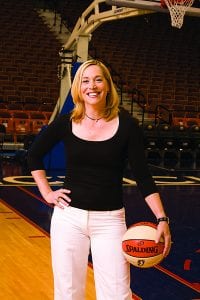
“Bob and his staff have been able to hire really high-character, high-achieving people in their most important sports, and to retain that talent,” said Doris A. Burke ’87, ’92G, & ’05Hon., a basketball analyst for ESPN and a former Friar point guard. “The most important resource any institution can have is its people. If you have the right people doing the right jobs, success usually follows.”
Karl W. Anderson ’88, a member of the PC Board of Trustees and a former Friars soccer star, said he believes that the greatest achievement of PC athletics has been in building programs that will endure even after individuals depart.
“One of the passions that I share is the idea of building something that is sustainable,” said Anderson. “We are not totally reliant on individuals. We have built a program — and facilities and coaches are part of the program.”
When Driscoll came to PC, the College was raising only $200,000 a year for athletics. Fundraising had been one of Driscoll’s responsibilities in California, and he knew its value, not only for improving facilities, attracting coaches, and building competitive teams, but also for engaging alumni.
The 2001 season was painful for men’s soccer, which lost 14 games. Anderson asked Driscoll how he could help. Driscoll requested and received $5,000 to replace a carpet in the locker room. Three years later, Anderson donated $40,000 to renovate the locker room completely. Then, in 2014, Anderson and his wife, Kathleen T. “Kerry” Fowley Anderson ’88, gave $2 million to PC athletics.
The College is using $1.5 million of the Anderson gift to build Anderson Stadium, a soccer and lacrosse complex next to Schneider Arena. The synthetic-turf field will be named for former lacrosse player Michael J. Chapey ’86 and his wife, Maura Hurley Chapey ’86, who donated $1 million.
Coincidentally, the year of the Anderson gift was the best ever for men’s soccer, which won a program-record 16 games, captured its first BIG EAST title, and finished third in the nation, losing in overtime in the semifinal round of the NCAA Tournament.
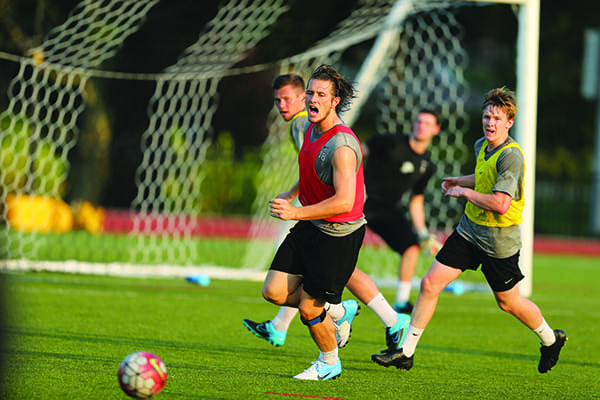
In 2014-15, PC raised $6 million for athletics, a single-year record. The fundraising team, led by Steven R. Napolillo ’98, senior associate athletic director for external relations, has raised $30 million in 10 years. The results can be seen throughout campus in improved facilities for student-athletes, students, faculty, and staff.
The changes began in 2005 with the construction of Lennon Family Field, a synthetic-turf field for field hockey and lacrosse. Two years later, the College opened the Concannon Fitness Center, which is used by students, faculty, staff, and alumni but also houses the Jimmy Walker Varsity Weight Room for student-athletes. The Canavan Sports Medicine Center was added in 2008. More recently, PC has renovated Joe Mullaney Gym, built the Ray Treacy Track, reconstructed Schneider Arena, and started work on new facilities for softball and tennis, in addition to the soccer and lacrosse complex.
Top high school athletes expect great facilities, said Burke.
“You can’t be competitive in this age of college athletics if you are not proactively enhancing the buildings and consistently maintaining the facilities,” Burke said. “Student-athletes are much more educated about the questions they ask. Every time I walk on campus, I’m struck by how pretty it is and how much development there has been, and how much it must enhance not only the student-athlete experience but the experience of every student.”
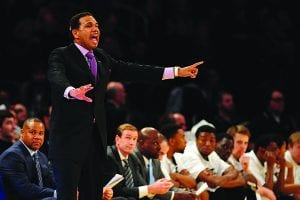
Hon. William C. Leary ’60 & ’10Hon., a College trustee and co-chair of the $140-million Our Moment fundraising campaign, is a longtime supporter of PC athletics. Leary said improvements to athletics facilities have been part of an overall campus beautification plan that includes construction of the Ruane Center for the Humanities, which opened in 2013, and the Arthur F. and Patricia Ryan Center for Business Studies, which is being built at the former Dore Hall and is expected to open in early 2017.
“Our campus is drop-dead gorgeous, and it gets better every single year,” said Leary. “I always say that if you get a prospective student on campus, PC is going to be his or her first choice.”
For all the emphasis on developing winning teams and improving facilities, the athletics program has not lost sight of its primary mission, which is to educate its students. PC’s student-athlete graduation success rate is 91 percent. Last year, student-athletes posted a combined grade point average (GPA) of 3.15 on a scale of 4.0 — the equivalent of a B, the best academic performance in more than 15 years.
The biggest improvement in GPA was recorded by the men’s basketball team. Driscoll attributes that success in part to the work of Marissa Mezzanotte as academic coordinator for men’s basketball, a position created in 2012.
Driscoll said Mezzanotte’s position demonstrates the College’s commitment to academic success for athletes. The job was created because of the unique pressures on time and travel affecting the men’s team. The players’ schedule is “exhausting, pressure-packed. People have no idea,” Driscoll said. In May 2015, he noted, every senior graduated.
“Marissa has brought an incredible amount of energy and focus to our academic component,” said Cooley. “Players trust her.”
The athletics staff makes sure student-athletes are a part of the community as well. Student-athletes logged 3,500 hours of community service last year. They volunteer in the Providence area, and they run programs on campus, such as the Girls on the Run 5K. An initiative of the women’s teams, it brings about 200 girls to PC each year.
“The athletics program encourages and enhances the atmosphere of the College,” Leary said. “It generates spirit, not only among students, but among alumni. It brings people back to the campus, and it gives us something to be proud of.”
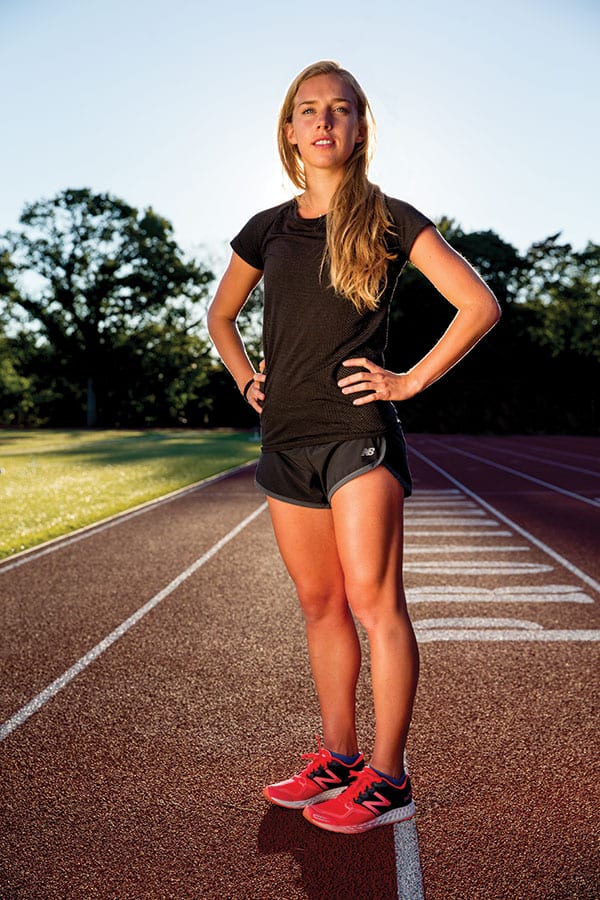
And then there are the intangible aspects of being a Friar.
Emily Sisson ’14, who is studying in PC’s MBA Program, is one of the most successful runners in College history. She led the women’s cross country team to its second national title in 2013, won the NCAA 5,000-meter title in indoor and outdoor track in 2015, and set a national record in the 5,000 indoors.
Being a student-athlete at PC is “like having a built-in family,” Sisson said.
Two years ago, PC’s runners were competing in an invitational meet in Boston. The swimming and diving team had just captured the Friars Cup, awarded to the athletics team with the most points in a competition based on academic performance, team results, and community involvement. The swimmers used their Friars Cup cash to charter a bus to Boston so they could be there to cheer on the runners.
That people would follow cross country and track so avidly was “shocking, because running isn’t really a spectator sport,” said Sisson.
“After we won nationals in 2013, we got back to campus pretty late at night,” Sisson said. “We got off the bus and everyone was outside Concannon, just waiting for us, and cheering. I don’t think you would have that experience at every school. It was really cool.”





